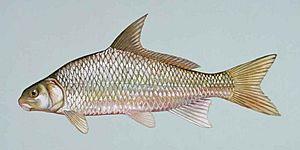River carpsucker facts for kids
Quick facts for kids River carpsucker |
|
|---|---|
 |
|
| Conservation status | |
| Scientific classification | |
| Synonyms | |
|
The river carpsucker (Carpiodes carpio) is a freshwater fish found in the inland United States and northern Mexico. This species has a slightly arched back and is somewhat stout and compressed. While the fins are usually opaque, in older fish they may be dark yellow. It is distributed along the Mississippi River basin from Pennsylvania to Montana. The river carpsucker, like other suckers, is a bottom feeder and obtains its nutrients from algae, microcrustaceans, and other various tiny planktonic plants and animals found in silty substrates. The river carpsucker typically lives about two to four years, but may survive for up to 10 years. It begins to reproduce typically in late spring, and the female usually releases more than 100,000 eggs; it reaches sexual maturity around two or three years old. After releasing and fertilizing their eggs, all parental care is ended.
Appearance and anatomy
The physical appearance of the river carpsucker is fairly distinctive. It is stout, with a somewhat compressed and arched back. The area around its dorsal fin is olive-brown before it fades to silver, with a white belly. In the young, the fins are usually opaque, while in the old, their fins are a dark yellow. The lower lip is projected in a similar fashion to a nipple at the midpoint, and big scales cover its whole body. It also has a distinctive 18 caudal fin rays. The species is frequently confused with non-native species, such as the various Asian carp species.
Distribution
The river carpsucker has historically occupied the Mississippi River basin from Pennsylvania to Montana. It also currently occupies the Gulf Slope Drainage from the Calcasieu River to the Rio Grande in Texas, Louisiana, and New Mexico. It was introduced to Lake Erie and the lower Maumee River, Ohio. It was supposedly deliberately introduced with a shipment of buffalo fish as a game species, and they are currently used in sport fishing. The effects of its introduction have not been studied, so are not well known. However, failure to find more river carpsuckers in the lower Maumee River suggests this species never took hold in this area. In the spring, they migrate upstream as the water temperatures begin to rise, and then move back downstream after spawning. They have been known to travel distances of up to 10 kilometers (6.2 mi).
Ecology
The river carpsucker is classified as a suction, or filter feeder, which means it typically eats algae and small planktonic animals and plants. They get their nutrients from filtering silt and detritus. As a bottom-feeder, it does not have very much competition, so its main worry is predation. It is typically preyed on by larger carnivorous fish such as northern pike, muskellunge, walleye, and largemouth bass, but only in its juvenile stage. Their largest predators are humans, although some larger birds, such as great blue herons, have been known to eat them. They can be found in large rivers and reservoirs, with sand or silt bottoms in slower-moving currents. The young typically are found in small streams, or tributaries. They are more abundant in areas with slower water velocity and moderate temperatures.
Lifecycle
Male river carpsuckers reaches reproductive maturity at age two to three, while females reach sexual maturity at age three to four. During breeding season, small tubercles can be observed on the body of the male. Reproduction typically occurs during late spring, in large spawning groups. The female can spawn more than once per year, and usually releases more than 100,000 eggs. The eggs are typically adhesive and demersal with a diameter of about 1.7 to 2.1 millimeters (0.067 to 0.083 in), and they typically hatch within eight to 15 days. To spawn, the temperature of the water must be 18.3 to 19.1 °C (64.9 to 66.4 °F), and spawning ends around the beginning of summer when water temperatures begin to rise. They exhibit no parental care; instead, they broadcast their eggs onto the sand and then leave them. Their lifespans are typically about two to four years, but individuals have lived up to the age of ten. They are schooling fish and will often be found in large groups.
Relationship with people
The river carpsucker currently has no established management plans, but is frequently caught by commercial fisherman for food, though they are not officially considered a game species. However, they are in large abundance in a few areas in their range. They are very plentiful in Elephant Butte Reservoir and Caballo Lake in New Mexico. They also can be affected by humans; their population begins reducing rapidly with the introduction of toxins into their habitat. The world record for the species stands at 13lb 4 oz caught in Cass County Nebraska in 1999.
See also
 In Spanish: Carpiodes carpio para niños
In Spanish: Carpiodes carpio para niños


